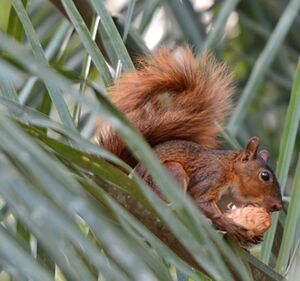Southern Amazon red squirrel facts for kids
Quick facts for kids Southern Amazon red squirrel |
|
|---|---|
 |
|
| Conservation status | |
| Scientific classification | |
| Genus: |
Sciurus
|
| Species: |
spadiceus
|
| Subspecies | |
|
|
The southern Amazon red squirrel (Sciurus spadiceus) is a type of squirrel that lives in South America. You can find it in the forests of north-western South America, mostly east of the Andes mountains. There are three main kinds, or subspecies, of this squirrel.
This squirrel is usually a dark red or dark brown color. It often has lighter, whitish fur on its belly. It can grow to be about 48 to 63 centimeters (19 to 25 inches) long, including its very long tail. These squirrels spend a lot of time on the ground, looking for food like nuts. They are quite friendly and often eat together in the same tree. Scientists don't know much about how they have babies. This squirrel is not in danger. It lives in many places and there are lots of them. Because of this, it is listed as a "least-concern species" by the International Union for Conservation of Nature.
Contents
What Does the Southern Amazon Red Squirrel Look Like?
This squirrel is one of the biggest squirrels in its home area. It can be from 48 to 63 centimeters (19 to 25 inches) long. This includes its very long tail, which is about 24 to 34 centimeters (9 to 13 inches) long. Boy and girl squirrels are about the same size. They usually weigh between 570 and 660 grams (1.2 to 1.5 pounds).
Their fur is often reddish-brown over most of their body. It might have lighter yellow bits mixed in. Some squirrels, especially the S. s. tricolor kind, can be dark brown or almost black. Their bellies are white or a light yellow color. A thin band of dark fur separates the belly from the rest of the body. Their cheeks and head can be yellow to reddish-orange. The tail starts dark brown near the body and turns orange along most of its length.
The southern Amazon red squirrel looks a lot like the northern Amazon red squirrel. But the southern one has a longer, thinner head. It also has orange fur behind its ears and on the tops of its feet. Female squirrels have eight teats.
Where Do Southern Amazon Red Squirrels Live?
The southern Amazon red squirrel lives in north-western South America. You can find them east of the Andes mountains. They live in southern Colombia and western Ecuador. They also live across eastern Peru, northern Bolivia, and Brazil south of the Amazon River. Most of these squirrels live in low-lying rain forests. However, in the western parts of their home, some live in forests high up in the Andes foothills.
Scientists currently know about three different kinds, or subspecies, of this squirrel. We don't yet know exactly where the areas for each kind begin and end:
- Sciurus spadiceus spadiceus - mostly found in Brazil
- Sciurus spadiceus steinbachi - mostly found in Bolivia
- Sciurus spadiceus tricolor - mostly found in Peru
Daily Life and Habits
Southern Amazon red squirrels spend a lot of their time on the ground. They also like to be among thick plants close to the ground. But they can easily climb trees. They go up into the forest canopy (the top layer of trees) when there are big floods during the wet season. These squirrels are common in their home areas. There can be about 3.8 to 6.6 squirrels in every square kilometer. Each squirrel usually roams over an area of about 25 to 50 hectares (62 to 124 acres).
They are active during the day (this is called diurnal). They eat plants (this is called herbivores). Their main food is large, hard-shelled nuts. Some of these nuts come from trees like murumuru, Attalea, and Dipteryx. Bigger animals that hunt these squirrels include ocelots and jaguars.
These squirrels do not fight over their living space. Several squirrels will often eat from the same tree at the same time. They hide nuts on the ground for later. When they feel scared, they usually go down to the ground. They don't usually jump between tree branches. People have heard them make alarm calls. These calls sound like a sneeze followed by a chattering noise.
Reproduction and Life Cycle
Most details about how these squirrels have babies are not clear. But it is known that female squirrels usually give birth to two to four baby squirrels at a time.


